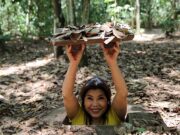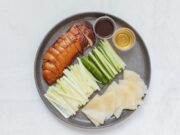If you are visiting Ho Chi Minh City in Vietnam then exploring Cu Chi Tunnels must be on your list. These tunnels are situated a short drive from the city. Cu Chi Tunnels are a part of Vietnam’s history, the war the brave Vietnamese people fought against the United States of America, which resulted in the kick out of American forces. These tunnels were made by Vietnamese rebels to guard against the American Shelling and bombings. In present times only a short patch of these tunnels exist, but is a must-see place, for anyone interested in war history and adventure.
Cu Chi tunnels are a network of maze-like tunnels spread across 120 kilometers which was used by the Viet Cong during the Vietnam War. These tunnels are around 60 kilometers away from Ho Chi Minh City, set amidst the lush greenery of the Vietnamese countryside.
Brief History of Cu Chi Tunnels
The region where Cu Chi Tunnels are situated was a vast rubber plantation site of the past, which was owned by a French Tire Company. The first of these tunnels was dug in the late 1940s by the anti-colonial Viet Minh, primarily for storing arms and hiding fighters. Later on, in the time of late 1950, it was taken over by the Viet Cong, and by 1965 hundreds of kilometers of tunnel network was dug up.
The tunnels of Cu Chi could be as small as 80cm wide and 80cm high at many points, and could also go 4 level deep. The air vents of these tunnels were camouflaged with grass. To ward off the American sniff dogs, the Viet Cong even sprinkled pepper around the air vents. These tunnels were the base of the Viet Cong for continuing their Guerrilla warfare. The tunnels during the war had become like underground villages with kitchens, living areas, and hospitals, along with ammunition storage rooms, command rooms, and bomb shelters. By keeping Cu Chi Tunnels as a base Viet Cong set booby traps for enemies, they would set trip wires with grenades, and they would dig camouflaged pits with sharpened bamboo sticks. The war eventually ended in 1975, while in 1976 the Vietnamese government turned it into a war memorial.
Cu Chi Tunnels Locations
There are two popular Cu Chi Tunnel sites that are visited by the majority of travelers. They are, Ben Dinh and Ben Duoc. Out of them, Ben Dinh is the more popular one, which is also located closer to Ho Chi Minh City, and is more crowded when it comes to travelers. On the other hand, Ben Duoc is the one that is less popular, not crowded or cramped with travelers, and is a bit farther from Ho Chi Minh City as compared to Ben Dinh.
When you enter the sites, the tour guide will apprise you of the architecture of the tunnels. It has different levels, with medical bunkers, along with meeting bunkers, and kitchens with chimneys, along with storage for food, medicine and weapons. There are also dedicated triangular bunkers made for children and pregnant women. The tunnels also had underground wells for water supply as the warriors couldn’t rely on the water from rivers as it could be poisoned with chemicals.
Ben Dinh
It is the touristier version of the Cu Chi Tunnels. In fact, the tunnels at this site were deliberately widened and reconstructed so that more travelers could visit them. The site is also home to a shooting range with weapons like AK 47 and M16s. At this site, you can also indulge in a game of paintball and do kayaking.
When visiting Ben Dinh you will be started with a thatched hut and a little literature about the site. You will also get to see real life booby traps, abandoned tanks, and trap doors. The guides will also show you how the smoke from underground tunnels was dispersed without revealing its source.
Ben Duoc
Ben Douc is relatively less crowded than Ben Dinh. In case if you are really interested in exploring the historical remains of these tunnels in detail and in their raw form then visit this site. At this site the tunnels are narrow and rougher, something we should warn you ahead of time. But people who like adventure are going to love it. The tunnel network of Ben Duoc is five times bigger than that of Ben Dinh. Here you can also visit the Ben Duoc Memorial Temple. At this site, you can also get the actual soldier uniforms that you can wear and get into the tunnels for a more realistic experience.
Spots to explore at these Sites
When you will enter the Ben Dinh Site, just near the ticketing counter you will find the weapons gallery. It is home to the weapons and ammunition which were used in the Vietnam War. It is a perfect place for people who are more interested in the history of the war.
At the site, you will also find a documentary film room where you can watch a short film on how the Cu Chi Tunnels were built. History buffs are going to like it, and normal folks will also find it interesting to see the history of something they are going to experience.
One of the picture-worthy sites of the sites is the tiny hiding spot, where Viet Cong Warriors used to hide during bombings and cover the top with the lid. Travelers find it interesting to see if they can fit in these spots by leaping into them.
The site also has a dummy Military workshop where the Viet Cong used to convert bullets into landmines. The site also has a dummy sandal-making workshop where the Viet Cong used to make sandals from recycled tires. At times they used to make the sandal sole backward to mislead the enemies in case they tried to track the footprints in the forest.
What else to visit near Cu Chi Tunnels – Cu Chi Wildlife Rescue Station
The wildlife rescue station is located between Ben Duoc and Ben Dinh. It is around 8 kilometers far from the main tourist area. It is spread across 4000 square meters of area and is considered to be the largest rescue station in Southern Vietnam.
It was established back in the year of 2006. The station is built to rescue more than 3500 species of animals that are threatened with extinction from the natural ecosystem of Vietnam. The rescue station also houses abused animals or animals that have been the victim of relentless trapping. If you visit this rescue station then you must interact with the staff members who will apprise you of the natural ecosystem of the region and they also have lots of stories to tell about animal rescue.
What else to visit in Cu Chi Tunnels – Swimming Pool Resembling East Sea
A long day of exploration of these tunnels can exhaust the strongest of men. So to refresh you and give you a spark of whole new energy there is a swimming pool in the Ben Duoc site that resembles the East Sea. It has crystal clear waters, and to top everything you can also enjoy some water sports in this pool. If you are traveling with family, especially with kids, then this spot is a must-visit, and will serve as a quick fun activity after a load of history walk back. The tickets to this pool start at a mere 20,000 VND per person.
What else to visit in Cu Chi Tunnels – Cu Chi Fruit Orchards
Southern Vietnam is known for having rich cultivation of fruits in many of its orchards. Cu Chi is also blessed for being the ground of exotic and lip-smacking tropical fruits. Some of the fruits that grow in this region are Jackfruit, Durian, Mangosteen, Rambutan, and Plum.
Near the sites of Cu Chi Tunnels, there are popular fruit orchards that go by the name of ‘Trung An’ and ‘Bay Trieu’ which can become your stop for a quick exploration. If you are travelling with family then a quick picnic in these fruit orchards can be a very good idea. You can also relish the fresh produce of the orchards and can also pick some for your way back home.
Cu Chi Tunnels Food
Vietnam is already popular across the world for its mouth-watering dishes, and cuisines that rule the menu of South East Asian Restaurants. When visiting the Cu Chi Tunnels you must keep this on your list to explore the local food.
After a thorough exploration of the tunnels, and seeing the ins and outs of the tunnel network, you must relish the local combination of dishes that include Jasmine Tea along with boiled tapioca root which is served with a mix of salted peanuts and sugar. You can find this powerful food combo at the Hoang Cam kitchen. We must also tell you that this was the staple food of the Viet Cong Warriors that kept them thriving throughout the war.
Live your life by a compass not a clock!









































